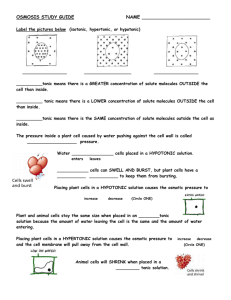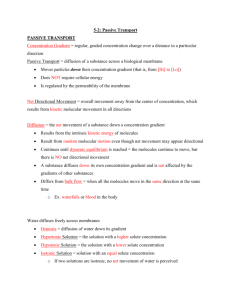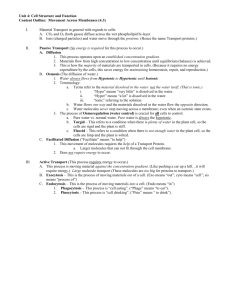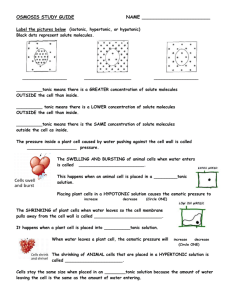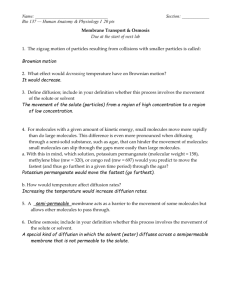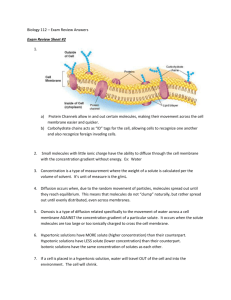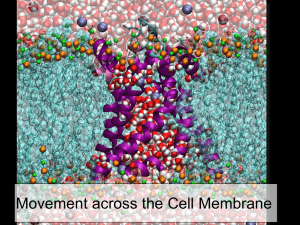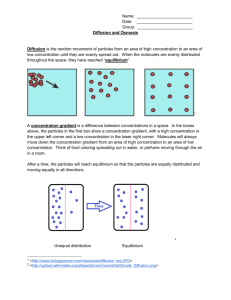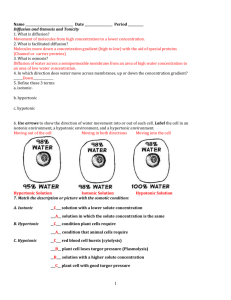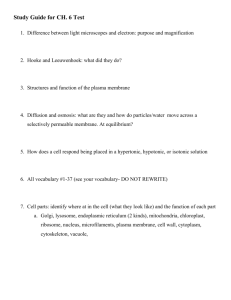Cellular Transport Worksheet
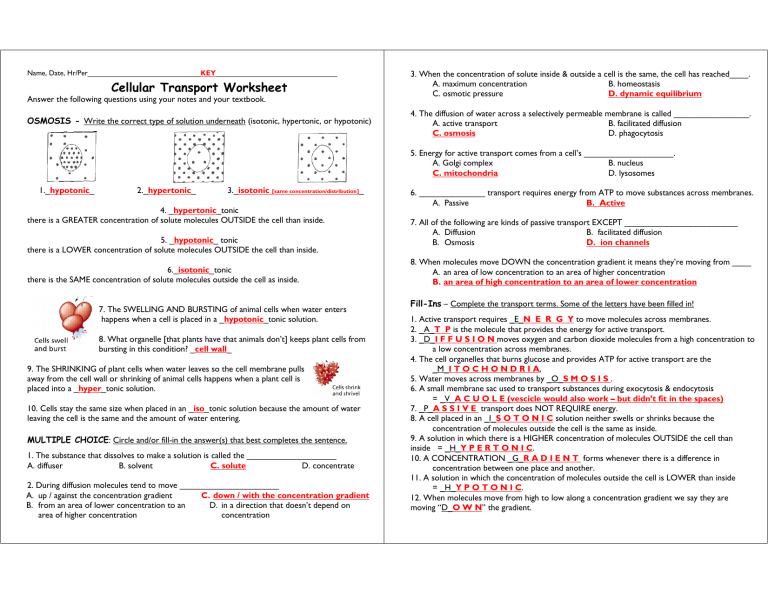
Name, Date, Hr/Per____________________________ KEY ______________________________
Cellular Transport Worksheet
Answer the following questions using your notes and your textbook.
OSMOSIS - Write the correct type of solution underneath (isotonic, hypertonic, or hypotonic)
1._
hypotonic _ 2._
hypertonic _ 3._
isotonic
[same concentration/distribution]
_
4. _ hypertonic _tonic there is a GREATER concentration of solute molecules OUTSIDE the cell than inside.
5. _ hypotonic _ tonic there is a LOWER concentration of solute molecules OUTSIDE the cell than inside.
6._
isotonic _tonic there is the SAME concentration of solute molecules outside the cell as inside.
7. The SWELLING AND BURSTING of animal cells when water enters
happens when a cell is placed in a _ hypotonic _tonic solution.
8. What organelle [that plants have that animals don’t] keeps plant cells from bursting in this condition? _ cell wall _
9. The SHRINKING of plant cells when water leaves so the cell membrane pulls away from the cell wall or shrinking of animal cells happens when a plant cell is placed into a _ hyper _tonic solution.
10. Cells stay the same size when placed in an _ iso _tonic solution because the amount of water leaving the cell is the same and the amount of water entering.
MULTIPLE CHOICE : Circle and/or fill-in the answer(s) that best completes the sentence.
1. The substance that dissolves to make a solution is called the ___________________
A. diffuser B. solvent C. solute D. concentrate
2. During diffusion molecules tend to move _____________________
A.
up / against the concentration gradient
B.
from an area of lower concentration to an
C.
down / with the concentration gradient
D.
in a direction that doesn’t depend on area of higher concentration concentration
3. When the concentration of solute inside & outside a cell is the same, the cell has reached____.
A. maximum concentration B. homeostasis
C. osmotic pressure D. dynamic equilibrium
4. The diffusion of water across a selectively permeable membrane is called ________________.
A. active transport
C. osmosis
B. facilitated diffusion
D. phagocytosis
5. Energy for active transport comes from a cell’s ___________________.
A. Golgi complex B. nucleus
C. mitochondria D. lysosomes
6. ______________ transport requires energy from ATP to move substances across membranes.
A.
Passive B. Active
7. All of the following are kinds of passive transport EXCEPT ________________________
A.
Diffusion B. facilitated diffusion
B.
Osmosis D. ion channels
8. When molecules move DOWN the concentration gradient it means they’re moving from ____
A.
an area of low concentration to an area of higher concentration
B.
an area of high concentration to an area of lower concentration
Fill-Ins – Complete the transport terms. Some of the letters have been filled in!
1. Active transport requires _E_ N E R G Y to move molecules across membranes.
2. _A_ T P is the molecule that provides the energy for active transport.
3. _D_ I F F U S I O N moves oxygen and carbon dioxide molecules from a high concentration to a low concentration across membranes.
4. The cell organelles that burns glucose and provides ATP for active transport are the
_M_ I T O C H O N D R I A ,
5. Water moves across membranes by _O_ S M O S I S .
6. A small membrane sac used to transport substances during exocytosis & endocytosis
= _V_ A C U O L E (vescicle would also work – but didn’t fit in the spaces)
7. _P_ A S S I V E transport does NOT REQUIRE energy.
8. A cell placed in an _I_ S O T O N I C solution neither swells or shrinks because the concentration of molecules outside the cell is the same as inside.
9. A solution in which there is a HIGHER concentration of molecules OUTSIDE the cell than inside = _H_ Y P E R T O N I C .
10. A CONCENTRATION _G_ R A D I E N T forms whenever there is a difference in concentration between one place and another.
11. A solution in which the concentration of molecules outside the cell is LOWER than inside
= _H_ Y P O T O N I C .
12. When molecules move from high to low along a concentration gradient we say they are moving “D_ O W N ” the gradient.
13. _O_ S M O T I C pressure is caused by water inside a plant cell pushing against the cell wall.
A
LOOK AT THE DIAGRAMS – The black dots represent solute molecules dissolved in water
1. In which beaker is the concentration of solute the greatest?
A or B
B
2. If the solute (dots) in this diagram is unable to pass through the dividing membrane, what will happen?
A. the water level will rise on the right side of the tube
B. the water level will rise on the left side of the tube
C. the water level will stay equal on the two sides
A. Isotonic
B. Hypertonic
C. Hypotonic
Match the description with the solution type:
1. _ C _ solution with a lower solute concentration (more water)
2. _ A _ solution in which the solute concentration is the same
3. _ C _ condition plant cells require
[otherwise the cell shrinks away from the membrane and the plant wilts]
4. _ A _ condition that animal cells require
5. _ C _ red blood cell bursts (cytolysis)
6. _ B _ plant cells shrink (plasmolysis)
7. _ B _ solution with a higher solute concentration (less water)
8. _ C _ solution with a high water concentration [which means solute conc.]
Label the tonicity for each solution (isotonic, hypotonic, or hypertonic):
Pay close attention to the arrows!!!
_ hypotonic _ _ isotonic _ _ hypertonic _ _ hypotonic _ _ isotonic _ _ hypertonic _
Examine the pictures on the bottom of the left side of this page.
What [if anything] is different about the plant and animal cells in each of these states?
State Animal Cell Plant Cell
Hypertonic cell shrinks cell shrinks away from the cell wall
Isotonic cell remains the same size cell remains the same size
Hypotonic cell swells & bursts cell swells against the cell wall
Matching – Match each term to its definition. a. energy b. facilitated diffusion
_ H _1. Transport protein that provides a tubelike opening in the plasma
membrane through which particles can diffuse c. d. endocytosis passive transport
_ A _2. Is used during active transport but not passive transport
_ C _3. Process by which a cell takes in material by forming a vacuole
around it e. f. active transport exocytosis
_ D _4. Particle movement from an area of higher concentration to an
area of lower concentration
_ F _5. Process by which a cell expels wastes from a vacuole g. h. protein ion pump channel protein
_ B _6. A form of passive transport that uses transport proteins
_ E _7. Particle movement from an area of lower concentration to an
area of higher concentration
_ G _8. Transport protein that changes shape when a particle binds
with it
Short Answer –
1.
Name two factors that affect the rate of diffusion.
temperature [increase temp, increase diffusion bc particles speed up]
shape [some particles can move by simple diffusion, some can move through protein channels, and some have to move by ion carriers or by endo/exo-cytosis]
concentration [increase concentration, increase diffusion]
charge [no charge diffuses easily, charged particles do not]
solubility [if a substance not soluble…it often won’t diffuse in certain solvent]

